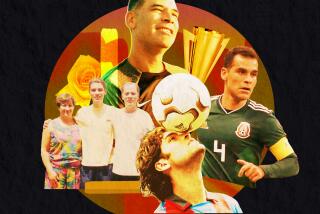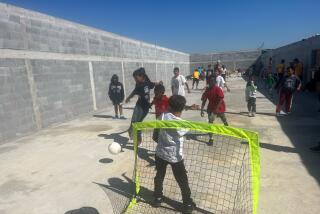Argentina’s cradle of tennis stardom
TANDIL, ARGENTINA, AND BOGOTA, COLOMBIA — Is it the city’s renowned cheese and sausage? Its clean air? Or does the credit for Tandil’s five world-class pro tennis players go mainly to no-nonsense coach Marcelo Gomez?
Whichever the case, Juan Martin del Potro’s recent U.S. Open victory has cast a spotlight on the medium-sized Argentine dairy town on the Pampas and has the tennis world pondering just what Tandil has going for it to produce so much athletic talent.
The 39-year-old Gomez trained the lanky Del Potro from the time he was barely able to hold a racket, and four other players currently on the men’s tour. For a town of 130,000, the number of tennis stars is unusually high.
Del Potro’s victory over Roger Federer at last month’s tournament in New York has made Gomez’s Independent Club a popular destination for journalists and tourists, all wondering the same thing.
“People ask what it is about this place, and I don’t have an answer. I think they should commission a scientific study to find out,” says a smiling Gomez during an interview at the club.
Such a study would almost certainly focus on the tightknit community’s rabid interest in sports, including soccer, rugby, field hockey and tennis, usually in that order. It might also elaborate on the work ethic of the city’s largely Italian, Spanish and Danish immigrant population.
It would note that virtually every shop in the quiet, granite-paved downtown seems to have posters of Del Potro and other home-grown sports stars, including Mauro Camoranesi, who plays in the Italian soccer league.
It might also highlight the tranquillity of a community 200 miles south of Buenos Aires, one that is surrounded by undulating hills, which attract weekend hikers and cyclists.
But in the end, this town’s successful development of pro tennis players is most often viewed as testimony to the youth program led by Gomez, a coach who found his niche as an 18-year-old college student looking for a way to finance his studies.
The tall, dark-featured native of Cordoba state, whose sun-dried skin tells of countless hours on the tennis court -- including 13 years training “Delpo,” as the 21-year-old Del Potro is known here -- rules over a highly structured training program at the semi-private Independent Club and its eight clay courts.
Del Potro, currently ranked fifth in the world, first picked up a racket at age 6 under Gomez’s tutelage. So did Juan Monaco (ranked No. 31) Maximo Gonzalez (68) and Diego Junqueira (165). In 2000, Gomez’s student Mariano Zabaleta reached a world ranking of No. 21, but has since slipped to 357.
Gomez describes himself as “energetic and serious, but not a shouter,” who runs a “militaristic” program.
A pro since age 17, Del Potro embodies the Gomez style of aggressive shot-making, of “giving everything you’ve got to the ball, hitting as hard as you can,” says the coach.
But Gomez says his training regimen also focuses on the mental aspects of the game.
“People consider me firm and clear in the ideas that I use with a player. I emphasize the spirit of humility, sacrifice, willpower and responsibility.”
Gomez has no tolerance for youths who “throw rackets, arrive late, or talk bad about others. They’re gone. They have to behave, show good manners. That’s nonnegotiable.” “Once players reach a certain level of success,” he says, “it’s important that they keep as low a profile as possible so they concentrate on their game and not the surroundings, something that in tennis, as in other sports, is very difficult.”
Gomez and his staff of six help top prospects in their teens seek athletic scholarships in the United States or pursue professional careers.
He says he has as little contact with players’ parents as possible: “Only when I run into them at tournaments.”
His full focus is on the 350 youths enrolled in his tennis program, who are assigned to one of four levels from beginner up.
Youths attend a minimum of two hourlong lessons a week that are open to anyone who can come up with the fee of $15 a month. Gomez’s assistants teach classes while Gomez restricts his direct contact to players at the “competition” level.
Argentines have been aware of Tandil as a tennis mecca for years. But the attention turned up a notch last year after Del Potro won four pro tournaments in a row. That raised expectations that the son of a veterinarian father and literature professor mother would make it to the top.
“What caught my eye was Juan Martin’s iron nerves, strength and will,” Gomez said. Del Potro’s height -- 6 feet, 6 inches -- also made him stand out. Early on he was dubbed “enano,” or “midget,” by his buddies.
Del Potro’s victory in the Open and his parade through town before 40,000 people days later solidified the status of Gomez as a tennis guru, and the city as a sports cradle.
Retired schoolteacher Ana Maria Andersen said later that the city was enthralled by the young star because “he’s humble and hasn’t changed with success.”
“The first thing he did after the Open was come to share his triumph with us. He’s an example we should value.”
Predictably, enrollment at Gomez’s academy has jumped; it includes recent arrivals from Venezuela, Peru, Ecuador and Colombia.
“We expect a lot more kids to get closer to tennis,” Gomez said. “It forms kids for life with good values.”
--
D’Alessandro and Kraul are special correspondents.
More to Read
Sign up for Essential California
The most important California stories and recommendations in your inbox every morning.
You may occasionally receive promotional content from the Los Angeles Times.










